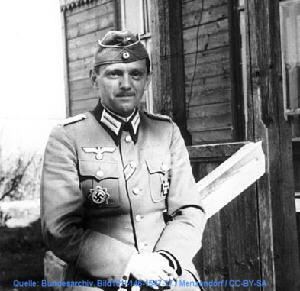Years of service 1922–44 Name Helmuth Stieff | ||
 | ||
Born 6 June 1901Deutsch Eylau, West PrussiaGerman Empire ( 1901-06-06 ) Commands held Chief of Organisation at OKH Awards German Cross in GoldIron Cross 1st ClassIron Cross 2nd Class Died August 8, 1944, Plotzensee Prison, Berlin, Germany | ||
Hellmuth Stieff (6 June 1901 – 8 August 1944) was a German general and a member of the OKH (German Army Headquarters) during World War II. He took part in attempts by the German resistance to assassinate Adolf Hitler on 7 and 20 July 1944.
Contents

Career

Stieff was born in Deutsch Eylau (now Iława, Poland) in the province of West Prussia. He was graduated from Infanterieschule München in 1922 and was commissioned a lieutenant of infantry. As early as 1927, young Stieff served in support of the German General Staff of the Reichswehr, the German army after World War I.

Stieff joined the Wehrmacht General Staff in 1938, serving in the Organisationsabteilung (coordination department) under Major Adolf Heusinger. Recognised for his excellent organisational skills, Stieff in October 1942 was appointed Chief of Organisation at OKH, despite Hitler's strong personal dislike. Hitler called the young, diminutive Stieff a "poisonous little dwarf."
From the 1939 Invasion of Poland onwards, Stieff conceived an abhorrence for the Nazi military strategy. When in Warsaw in November 1939, he wrote letters to his wife expressing his disgust for and despair over Hitler's conduct of the war and the atrocities committed in occupied Poland. He wrote that he had become the "tool of a despotic will to destroy without regard for humanity and simple decency".
Resistance fighter
Invited by General Henning von Tresckow, Stieff joined the German resistance in summer 1943. Taking advantage of being in charge of Organisationsabteilung, he acquired and kept all sorts of explosives, including some from foreign sources. He provided the explosives for von dem Bussche's cancelled assassination attempt on Hitler at the Wolfsschanze (Wolf's Lair) in November.
As one of the officers who had occasional access to Hitler, he volunteered to kill Hitler himself in a suicide attack, but later backed away despite repeated requests from Tresckow and Colonel Claus von Stauffenberg to carry out the assassination. On 7 July 1944, during a demonstration of new uniforms to Hitler at Schloss Klessheim, a palace near Salzburg, Stieff was indisposed to trigger the bomb. Stauffenberg therefore decided to kill Hitler himself.
In the morning of 20 July, Stieff flew with Stauffenberg and Lieutenant Werner von Haeften in the Heinkel He 111 plane provided by General Eduard Wagner from Berlin to the Wolfsschanze. In the night he was arrested and brutally interrogated under torture by the Gestapo. Stieff held out for several days against all attempts to extract the names of fellow conspirators. Ousted by the Wehrmacht, he was tried by the People's Court (Volksgerichtshof) under President Roland Freisler and sentenced to death on 8 August 1944. At Hitler's personal request, Stieff was executed by hanging in the afternoon of that same day at Plötzensee Prison in Berlin.
